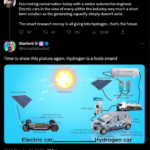An environmental issue about landfills is the landfill gas they invariably produce. Landfill gas is largely methane, and methane is a very potent greenhouse gas with 20x or more the greenhouse effect than carbon dioxide. There are many projects underway to mitigate methane production from landfills. On Nov 2, 2009 Waste Management Inc and the Linde Group announced a demonstration plant to convert landfill gas to Liquified Natural Gas (LNG), and they are using this LNG as fuel in their trucks. The facility is the world’s largest landfill gas (LFG) to liquefied natural gas (LNG) plant.
Landfill gas comes from the natural decomposition of biomass in landfills. The biomass ranges from kitchen waste to paper and any other biological material that makes its way into the landfills. Methane is a natural byproduct of such decomposition. There are over 1700 landfills in the U.S., 477 of which are owned by Waste Management Inc. The EPA has estimated the gas emitted by all those landfills could generate well over 2 gigawatts of electricity, if it were captured and burned in electric plants. It’s known that when landfill gas is burned its toxicity is greatly reduced, but it still results in carbon dioxide emissions. The gain is that carbon dioxide is a far less virulent greenhouse gas than is methane. Additionally converting landfill gas to a fuel can displace use of fossil fuels resulting in other environmental gains.
The new plant, at the Altamont Landfill near Livermore, was built and operated by Linde in cooperation with Waste Management. They have produced 200,000 gallons of LNG fuel since September and expect the plant to produce 13,000 gallons per day, enough to fuel all of Waste Managements trucks in California.
This plant fits with two of the Governor Schwarzenegger’s environmental directives: the Bioenergy Action Plan, which seeks to advance the use and market development of biomass as a transportation fuel, and Executive Order S-3-05, which aims to reduce the state’s greenhouse gas emissions by 25 percent by 2020. Four California agencies contributed to the cost of the project. These include the California Integrated Waste Management Board, the California Air Resources Board, the California Energy Commission and the South Coast Air Quality Management District.
“As California continues to move forward with its nation-leading policies to fight global warming, we need a diverse, dependable and environmentally sound mix of energy supplies to meet the needs of our people and our economy,” said Governor Schwarzenegger. “I am pleased to see the market responding as California continues to attract and grow more clean-tech and green-tech businesses and projects just like this LNG facility that will provide consumers with a cleaner-burning, alternative fuel source.”
As noted in the TechnoSanity Podcast, a 2003 report from the NRDC claims landfill gas projects like this are a secondary priority. The NRDC report suggests it would be better to divert the biomass from being put into the landfill in the first place. There are more efficient ways to biodigest the biomass than in a landfill. However the practical consideration is the two problems of separating biomass-waste the rest of the trash stream, and the existing landfills which are all producing landfill gas.
Linde and Waste Management commission world’s largest landfill to liquefied natural gas facility![]()
TechnoSanity #31: A look at Waste Management and landfill gas energy resources![]()
- Is there enough Grid Capacity for Hydrogen Fuel Cell or Battery Electric cars? - April 23, 2023
- Is Tesla finagling to grab federal NEVI dollars for Supercharger network? - November 15, 2022
- Tesla announces the North American Charging Standard charging connector - November 11, 2022
- Lightning Motorcycles adopts Silicon battery, 5 minute charge time gives 135 miles range - November 9, 2022
- Tesla Autopilot under US Dept of Transportation scrutiny - June 13, 2022
- Spectacular CNG bus fire misrepresented as EV bus fire - April 21, 2022
- Moldova, Ukraine, Georgia, Russia, and the European Energy Crisis - December 21, 2021
- Li-Bridge leading the USA across lithium battery chasm - October 29, 2021
- USA increasing domestic lithium battery research and manufacturing - October 28, 2021
- Electrify America building USA/Canada-wide EV charging network - October 27, 2021










